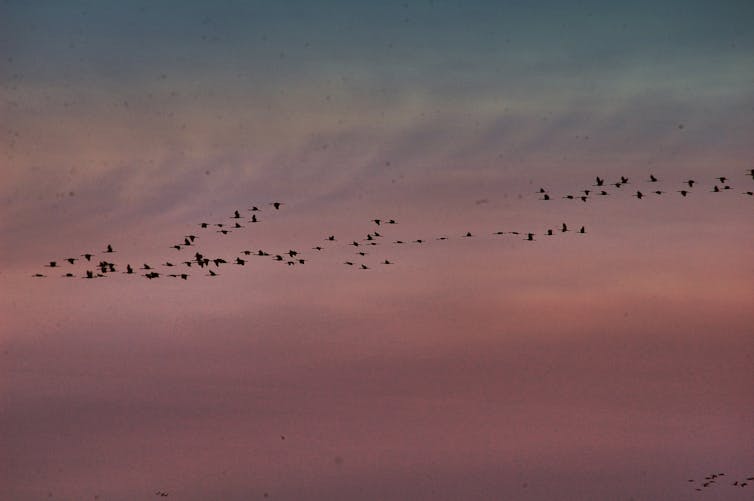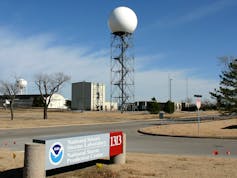By Miguel Jimenez, Colorado State University
With chatbots like ChatGPT making a splash, machine learning is playing an increasingly prominent role in our lives. For many of us, it’s been a mixed bag. We rejoice when our Spotify For You playlist finds us a new jam, but groan as we scroll through a slew of targeted ads on our Instagram feeds.
Machine learning is also changing many fields that may seem surprising. One example is my discipline, ornithology – the study of birds. It isn’t just solving some of the biggest challenges associated with studying bird migration; more broadly, machine learning is expanding the ways in which people engage with birds. As spring migration picks up, here’s a look at how machine learning is influencing ways to research birds and, ultimately, to protect them.
 Sandhill cranes flying above the Platte River in Nebraska.
Sandhill cranes flying above the Platte River in Nebraska.
shannonpatrick17/Flickr, CC BY
The challenge of conserving migratory birds
Most birds in the Western Hemisphere migrate twice a year, flying over entire continents between their breeding and nonbreeding grounds. While these journeys are awe-inspiring, they expose birds to many hazards en route, including extreme weather, food shortages and light pollution that can attract birds and cause them to collide with buildings.
Our ability to protect migratory birds is only as good as the science that tells us where they go. And that science has come a long way.
Free Reports:
 Get our Weekly Commitment of Traders Reports - See where the biggest traders (Hedge Funds and Commercial Hedgers) are positioned in the futures markets on a weekly basis.
Get our Weekly Commitment of Traders Reports - See where the biggest traders (Hedge Funds and Commercial Hedgers) are positioned in the futures markets on a weekly basis.
 Sign Up for Our Stock Market Newsletter – Get updated on News, Charts & Rankings of Public Companies when you join our Stocks Newsletter
Sign Up for Our Stock Market Newsletter – Get updated on News, Charts & Rankings of Public Companies when you join our Stocks Newsletter
In 1920, the U.S. Geological Survey launched the Bird Banding Laboratory, spearheading an effort to put bands with unique markers on birds, then recapture the birds in new places to figure out where they traveled. Today researchers can deploy a variety of lightweight tracking tags on birds to discover their migration routes. These tools have uncovered the spatial patterns of where and when birds of many species migrate.
However, tracking birds has limitations. For one thing, over 4 billion birds migrate across the continent every year. Even with increasingly affordable equipment, the number of birds that we track is a drop in the bucket. And even within a species, migratory behavior may vary across sexes or populations.
Further, tracking data tells us where birds have been, but it doesn’t necessarily tell us where they’re going. Migration is dynamic, and the climates and landscapes that birds fly through are constantly changing. That means it’s crucial to be able to predict their movements.
Using machine learning to forecast migration
This is where machine learning comes in. Machine learning is a subfield of artificial intelligence that gives computers the ability to learn tasks or associations without explicitly being programmed. We use it to train algorithms that tackle various tasks, from forecasting weather to predicting March Madness upsets.
But applying machine learning requires data – and the more data the better. Luckily, scientists have inadvertently compiled decades of data on migrating birds through the Next Generation Weather Radar system. This network, known as NEXRAD, is used to measure weather dynamics and help predict future weather events, but it also picks up signals from birds as they fly through the atmosphere.
Andrew J. Oldaker/Wikipedia, CC BY-SA
BirdCast is a collaborative project of Colorado State University, the Cornell Lab of Ornithology and the University of Massachusetts that seeks to leverage that data to quantify bird migration. Machine learning is central to its operations. Researchers have known since the 1940s that birds show up on weather radar, but to make that data useful, we need to remove nonavian clutter and identify which scans contain bird movement.
This process would be painstaking by hand – but by training algorithms to identify bird activity, we have automated this process and unlocked decades of migration data. And machine learning allows the BirdCast team to take things further: By training an algorithm to learn what atmospheric conditions are associated with migration, we can use predicted conditions to produce forecasts of migration across the continental U.S.
BirdCast began broadcasting these forecasts in 2018 and has become a popular tool in the birding community. Many users may recognize that radar data helps produce these forecasts, but fewer realize that it’s a product of machine learning.
Currently these forecasts can’t tell us what species are in the air, but that could be changing. Last year, researchers at the Cornell Lab of Ornithology published an automated system that uses machine learning to detect and identify nocturnal flight calls. These are species-specific calls that birds make while migrating. Integrating this approach with BirdCast could give us a more complete picture of migration.
These advancements exemplify how effective machine learning can be when guided by expertise in the field where it is being applied. As a doctoral student, I joined Colorado State University’s Aeroecology Lab with a strong ornithology background but no machine learning experience. Conversely, Ali Khalighifar, a postdoctoral researcher in our lab, has a background in machine learning but has never taken an ornithology class.
Together, we are working to enhance the models that make BirdCast run, often leaning on each other’s insights to move the project forward. Our collaboration typifies the convergence that allows us to use machine learning effectively.
A tool for public engagement
Machine learning is also helping scientists engage the public in conservation. For example, forecasts produced by the BirdCast team are often used to inform Lights Out campaigns.
These initiatives seek to reduce artificial light from cities, which attracts migrating birds and increases their chances of colliding with human-built structures, such as buildings and communication towers. Lights Out campaigns can mobilize people to help protect birds at the flip of a switch.
As another example, the Merlin bird identification app seeks to create technology that makes birding easier for everyone. In 2021, the Merlin staff released a feature that automates song and call identification, allowing users to identify what they’re hearing in real time, like an ornithological version of Shazam.
This feature has opened the door for millions of people to engage with their natural spaces in a new way. Machine learning is a big part of what made it possible.
“Sound ID is our biggest success in terms of replicating the magical experience of going birding with a skilled naturalist,” Grant Van Horn, a staff researcher at the Cornell Lab of Ornithology who helped develop the algorithm behind this feature, told me.
Taking flight
Opportunities for applying machine learning in ornithology will only increase. As billions of birds migrate over North America to their breeding grounds this spring, people will engage with these flights in new ways, thanks to projects like BirdCast and Merlin. But that engagement is reciprocal: The data that birders collect will open new opportunities for applying machine learning.
Computers can’t do this work themselves. “Any successful machine learning project has a huge human component to it. That is the reason these projects are succeeding,” Van Horn said to me.![]()
About the Author:
Miguel Jimenez, Ph.D. student in Ecology, Colorado State University
This article is republished from The Conversation under a Creative Commons license. Read the original article.

- Flashpoint Friday: Bitcoin and Yen traders brace for Dec. 27 volatility Dec 26, 2024
- Canadian dollar declines after weak GDP data. Qatar threatens EU to halt natural gas exports Dec 24, 2024
- Goldman Sachs has updated its economic projections for 2025. EU countries are looking for alternative sources of natural gas Dec 23, 2024
- COT Bonds Charts: Speculator Bets led by SOFR 3-Months & 10-Year Bonds Dec 21, 2024
- COT Metals Charts: Speculator Bets led lower by Gold, Copper & Palladium Dec 21, 2024
- COT Soft Commodities Charts: Speculator Bets led by Live Cattle, Lean Hogs & Coffee Dec 21, 2024
- COT Stock Market Charts: Speculator Bets led by S&P500 & Russell-2000 Dec 21, 2024
- Riksbank and Banxico cut interest rates by 0.25%. BoE, Norges Bank, and PBoC left rates unchanged Dec 20, 2024
- Brent Oil Under Pressure Again: USD and China in Focus Dec 20, 2024
- Market round-up: BoE & BoJ hold, Fed delivers ‘hawkish’ cut Dec 19, 2024
